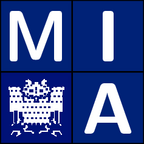
Welcome to the homepage of the lecture
Mathematical Morphology in Image Processing
Summer term 2007
Home
About Us
People
Teaching
Research
Publications
Awards
Links
Contact
Internal
Mathematical Morphology in Image Processing
Lecturer:
Dr. Bernhard Burgeth
Office Hours: Tuesday: 15:00-16:00.
Summer term 2007
Lectures (2h) with theoretical and programming assignments (1h);
5 ECTS points
Lectures: Thursday, 11-13 c.t., Building E13,
Lecture Hall 003
First lecture: Thursday 19th, 2007
Tutorials: 2 hours every second week; see below.
Certificates available now in room 111, bldg. E2 4 (Mathematics)
Tutorials – Prerequisites – Types of Lectures – Tutorials – Written Exam – Contents – Material for the Programming Assignments – Literature
This course is suitable for students of mathematics or computer science. It counts either as a theoretical course in computer science or as an applied mathematics course. It is based on mathematical knowledge from the first three semesters. For the programming assignments, some elementary knowledge of C is required. The lectures are given in English.
Mathematical Morphology is a discipline with a 40-year history
in image processing. Its techniques have been applied
successfully to a variety of image processing tasks that,
roughly speaking, involve shape information of image objects.
The lectures is divided into three parts:
The first part is devoted to the basic concepts and operations
of classical discrete morphology for scalar images
which rely on the notion of infimum and supremum, and
give rise to the so-called dilation and erosion.
Continuous non-flat morphology is the subject of the second part
of the lectures. Remarkably one can establish partial
differential equations (PDEs) that mimic the processes of dilation
and erosion. We will discuss these nonlinear evolution equations,
especially some sophisticated modern algorithms for their numerical
solution. Other PDEs help to explore the connection between
morphological operations and curve evolution of object boundaries.
Part three provides access to very recent research results:
We will see how morphological operations, both
the ordering and the PDE-based setting, can be transfered to
matrix-valued images. This data type makes its appearance in
diffusion tensor magnetic resonance imaging (DT-MRI) but also
in image processing itself, namely in the form of
structure tensor concepts.
The tutorials include programming and theoretical assignments. The programming assignments give an intuition about the way how morphological image processing algorithms work, while the theoretical assignments provide additional mathematical insights. The tutorials are conducted by the lecturer.
Update: Thursday, 14-16,
Building E2 5, HS 3 (theory)
Building E1 3, CIP 103 (programming)
A list with the student id numbers of all students qualified
for the exams can be found at the information board
next to the entrance of our work group.
In case of qualification, you are allowed to take part in both exams.
Only the better grade counts.
There are several rules during the exams:
- For the exams, you can use the course material (including lecture notes and example solutions from this web page) and hand-written tutorial notes, but no books.
- A non-programmable pocket calculator is required.
- Mobile phones, PDAs, laptops and other electronic devices have to be turned off.
- Please keep the student ID card ready for an attendance check during the exam.
The first written exam took place on Monday, July 30, 2007, from 2 PM
to 3:30 PM in lecture hall 001, building E1 4.
Course material will be made available on this webpage in order to
support the classroom teaching and the tutorials, not to replace
them. Additional organisational informations, examples and explanations
that may be relevant for your understanding and the exam are provided
in the lectures and tutorials.
| Date | Topic |
|---|---|
| 19.04. | Introduction and Basics |
| 26.04. | Dilation, Erosion, and Beyond |
| 10.05. | Opening, Closing and Applications |
| 10.05. | Morphological Reconstructions |
| 24.05. | Geodesic Distances |
| 14.06. | Morphological Filters |
| 14.06. | Morphological Segmentation |
| 21.06. | Morphological Segmentation II and Classification |
| 21.06. | Morphology and Convolution |
| 21.06. | Continuous Scale Morphology I (Assignments) |
| 05.07. | Continuous Scale Morphology II |
| 05.07. | Discrete Morphology for Matrix Fields |
| 12.07. | PDE-Based Morphology for Matrix Fields |
| 19.07. | Non-Flat Morphology and Slope Transform |
| 19.07. | Logarithmic Connection: LST and Morphology |
| Date | Topic |
|---|---|
| 21.06. | Programming Assignment: Basic morphological operations |
There is no specific book for this class, but some of the morphological image processing topics are treated in one of the following books:
- J.P. Soille: Morphological Image Analysis. Springer, Berlin, 2003.
- F. Cao: Geometric Curve Evolution and Image Processing. LNM 1805, Springer, Berlin, 2003.
These books can be found in the computer science library.
If you are looking for a specific reference, check out
Keith Price's Annotated Computer Vision Bibliography.
Numerous citations and online articles can be extracted from
the CiteSeer webpage.
MIA Group
©2001-2007
The author is not
responsible for
the content of
external pages.